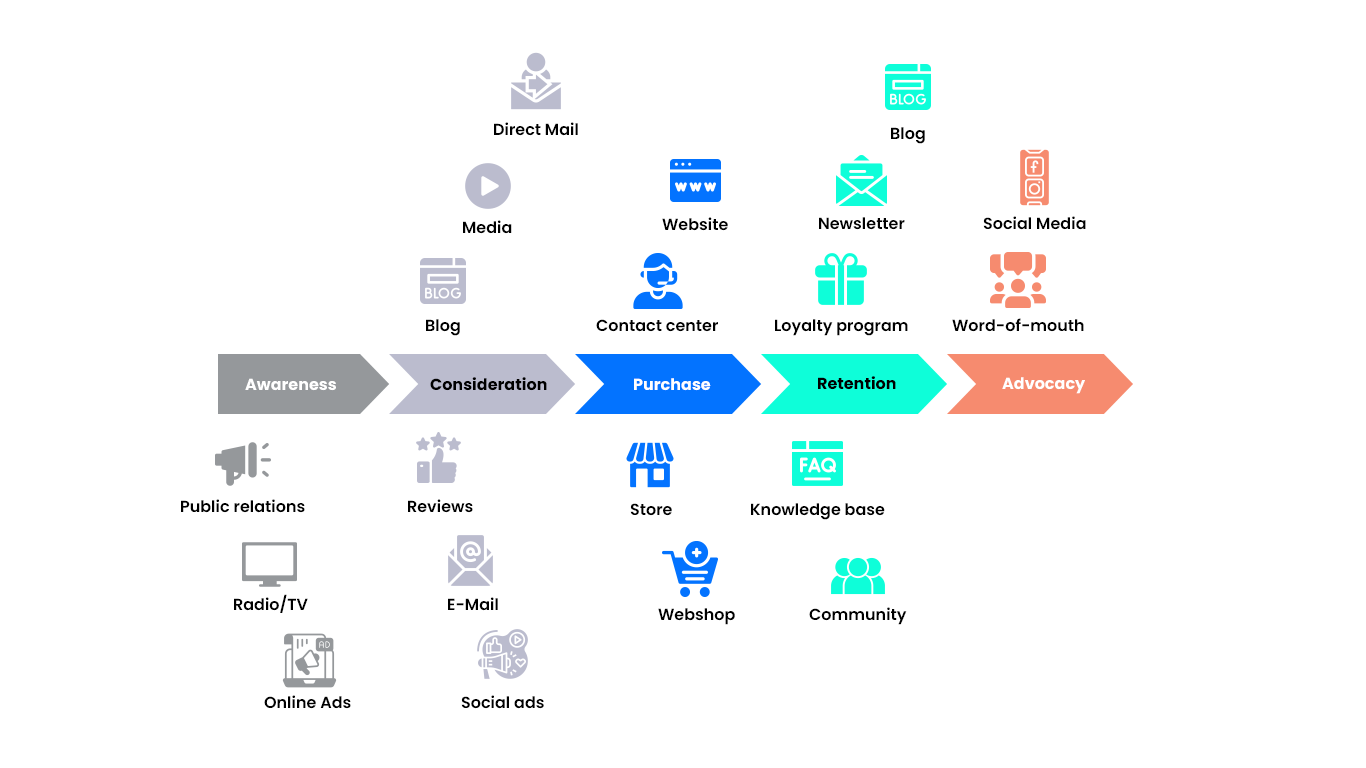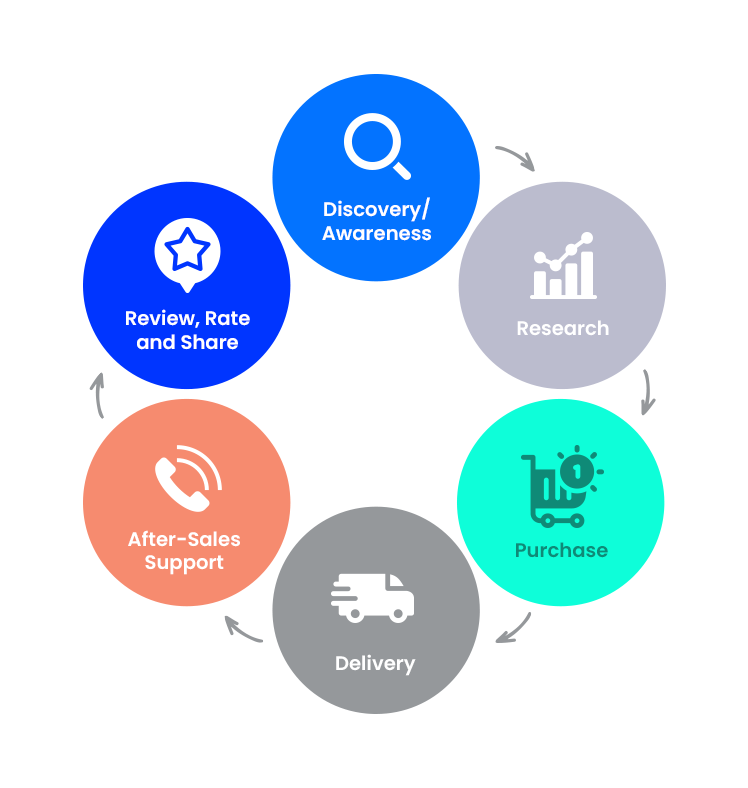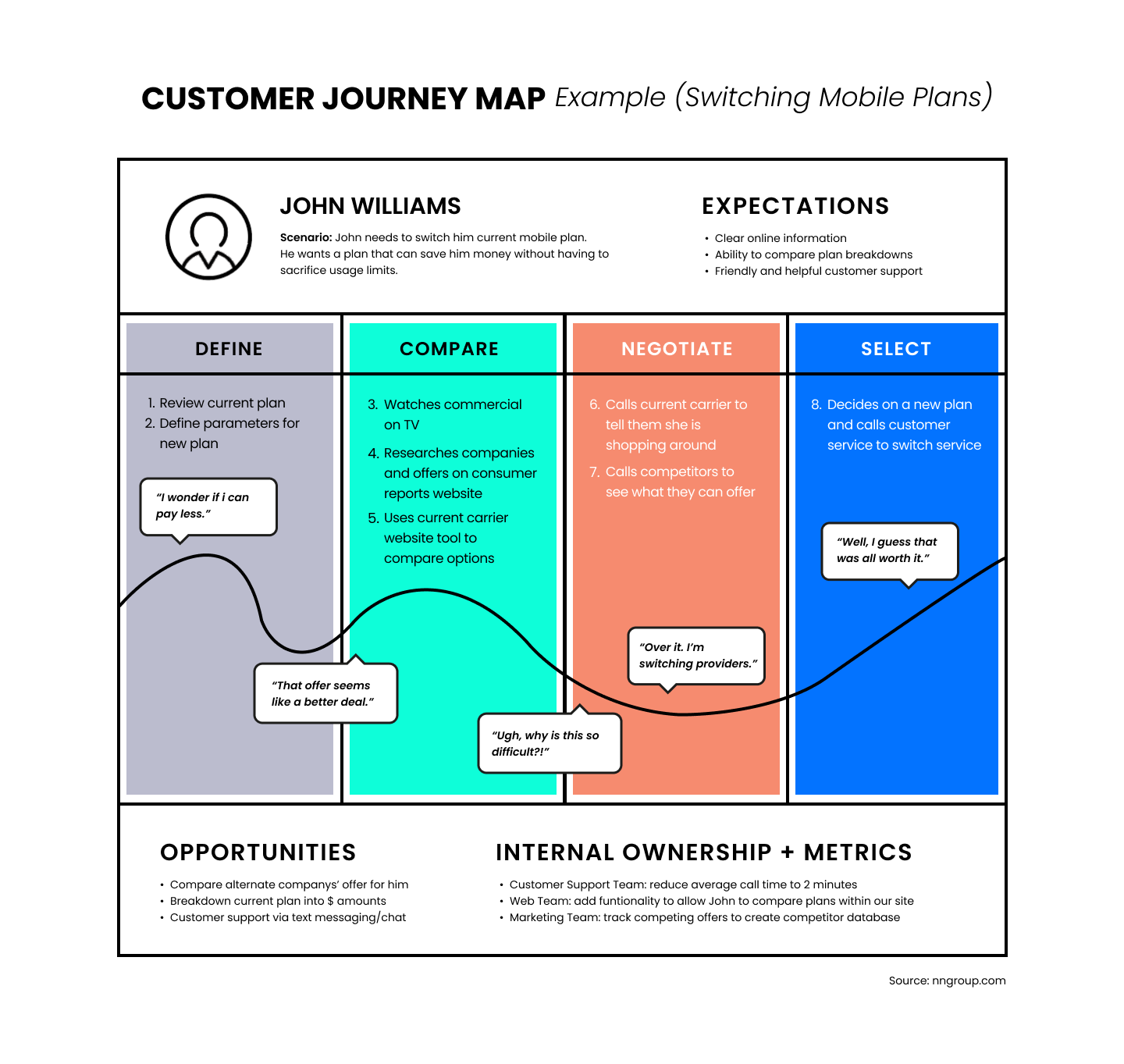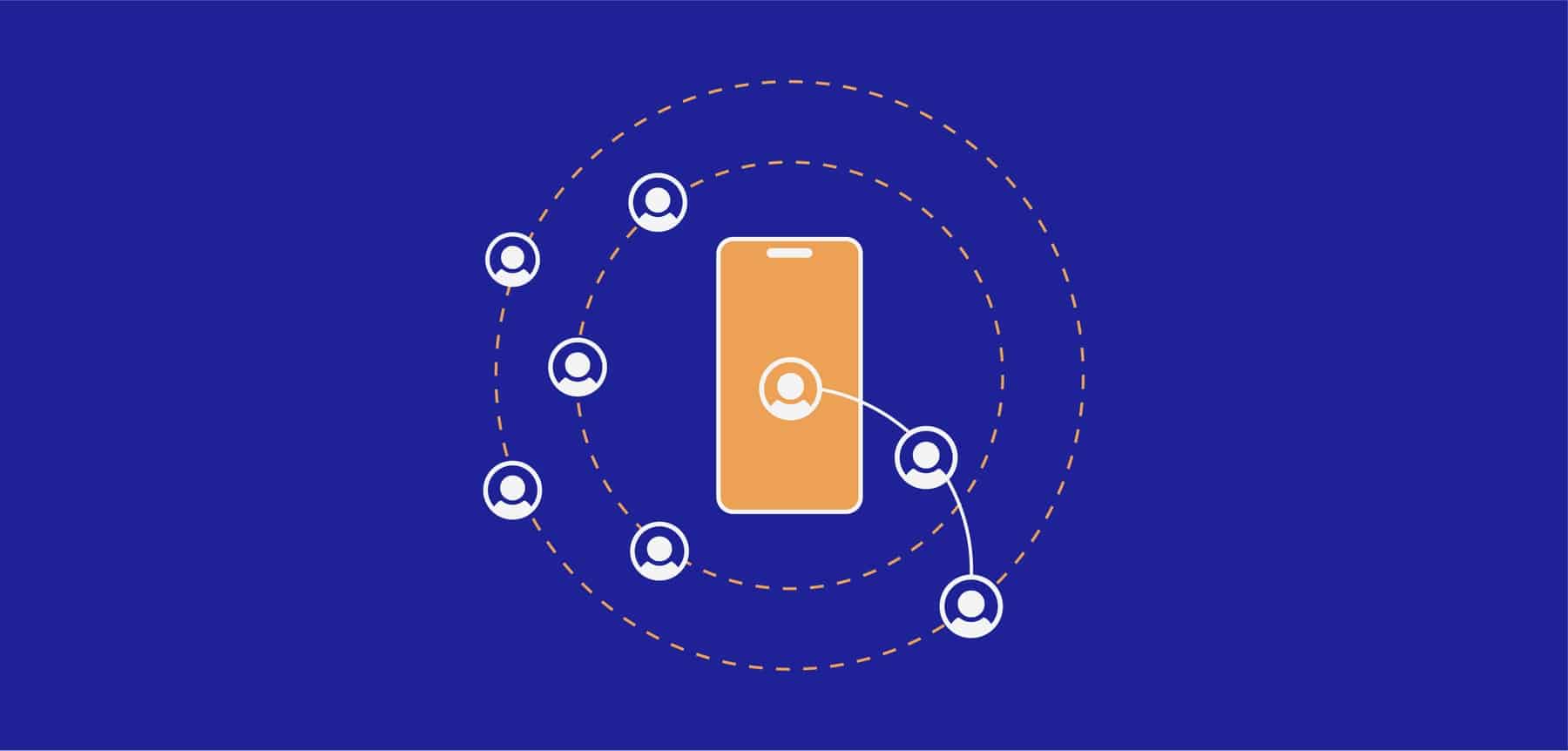Customer Journey Mapping Strategies
- Reading Time: 8 minutes
As customers interact with brands across ever more channels, almost all digitally, it’s more important than ever that companies know everything about each of those touchpoints, and how to optimize each one so they provide for a seamless experience for the customer.

You may not realize this yourself, but we’re all currently in what experts call “the 4th Industrial Revolution.” What this means is that we’re all busy navigating a world that’s not just digital anymore. It’s a world where we’re all getting more and more used to smart technology, and to interacting with the world across multiple planes and multiple channels, all of which are interlinked and automated themselves to various degrees.
In practice, what this means is that we’ve moved from a world where people built products that customers bought, to a world where factories produced products for customers all over the world, to a world where instantaneous communication became possible throughout the world, to the modern world, where customers purchase products across different channels, use those products in a variety of ways, and increasingly live a life that is digitized to unprecedented degrees.
Now, when a customer buys a product, they use on average over 6 channels to connect with businesses. Each of these connections represents a touchpoint along their journey with a product, and each of these touchpoints is crucial to the overall customer experience. Over 70% of customers see their journey with a product as more important than even the quality of the product itself.
Sign up to drive your business with the power of data
What is customer journey mapping?
And this is where customer journey mapping strategies come in. If customers are interacting with brands across an increasing number of touchpoints, and then also seeing their interactions across these touchpoints as increasingly important, then every brand needs to make sure they:
- Know what touchpoints are likely to be used
- Know how to optimize the experience across each touchpoint, including potential pain points
- Know how to synchronize these touchpoints into one seamless experience
This process is known as customer journey mapping. A customer journey map is a visual representation of each touchpoint with which a brand engages with a customer. It’s a way to put a brand into the mind of a customer, with the goal of improving their overall experience.
A customer journey map might look something like this:

What are the steps to create a customer journey map?
There are a number of critical elements to mapping out your customers’ journey. Above you’ve got the gist, but let’s dig down to the nuts and bolts of what you have to do to map out a full customer journey.
Ask relevant questions and gather data
This is possibly the most important step to mapping out your customer journey. It’s the first thing you have to do, and how effectively you do it will determine how successfully you are in mapping out everything to come. So, we’re going to spend some time going over exactly what data collection and data analysis entails. The first thing you have to do is narrow down the specific questions you want answered. For instance:
- Why do customers first engage with your company/brand/service/product?
- How do they first engage?
- What do they want from it?
- How do they interact/engage with you?
- When do they this?
- For how long do they interact with you?
- What are the touchpoints across which they interact with you?
- What are the pain points, or potential pain points?
- What are the points of concern? What are the points of progress?
- How easy to use do customers find it?
- Do customers feel that support is helping them?
- How satisfied are customers with the onboarding process?
- How satisfied are they with the checkout process?
- How likely are they to recommend the product/service to others?
When researching these questions, you’ll be using a mix of surveys, market research, focus groups, ethnographic studies, and analytics. Notice also that these questions are specific and answerable with an objective answer. Of course, you want the answer to questions like, “Does my product meet my customer’s expectations.” But That’s not a question that has a simple objective answer. What you’re trying to do is boil down those broad, uber important questions into bite-size answerable questions. Once you’ve optimized each answer to your liking, the answers to the broader questions you have will start to become clearer as well.
Identifying how your users discover your products
So you researched and gathered data regarding what the touchpoints were for you. As mentioned at the top of this article, these include just about every channel imaginable, including in-store, app-store, website, social media, email, livechat, search functions, telephone calls, SMS, in-app notifications, conferences, product demonstrations, sales calls, links, or others.
Once you’ve identified these touchpoints, you’ll want to burrow down into the nitty gritty of each one so that you can find a way to optimize it as you map out your customer’s journey. How does each touchpoint affect your customer? What problems might occur at each one? What course of action do customers take (or should they take) in case of a problem? Where can they find information? Is it easy for them to keep taking the next steps across channels and touchpoints? Dataroid can measure each click to take you through the customer’s entire journey.
As with everything else, the seamlessness of everything is of the absolute essence. If your sales team is great but your website isn’t, then eventually your customer will hit a bump in the road on their journey, and that might well be the point at which you lose them for good. It’s important that you use a product that makes sure it knows how customers will go through their journey, and also how the journey from the beginning of a touchpoint to its end will go as well.
Redefine these touchpoints in terms of the customer experience
What this means in practice is that you’re trying to identify what are the actions that your customers experience on their journey. Every type of customer is different, and journeys depend on what the product or service is, but you want to finetune the touchpoints you’ve identified from your perspective to theirs. A typical customer journey might look something like this:

But beyond that the point of this stage is really to dig down into the details of each touchpoint and what it means for the customer and their experience. You might actually want to identify the touchpoints for everything from potential issues to improving what customers already love most. For example if there’s a failed delivery or lack of satisfaction in some way. or the potential for that to arise in the future, how do the touchpoints you’ve identified correspond to the customer experience in that situation?
How can a customer journey map be applied?
A detailed and diligent customer journey map can shift a business’s focus onto the customer, through research, insights, and a focus on the touchpoints the customer interacts with most. This allows businesses to find pain points and act accordingly, before massive churn occurs to save their business and move forward into the future.

This is a two-part article describing customer mapping strategies. We’ve already introduced customer mapping, and highlighted the first three steps – and arguably the three most important steps – which are doing your research and gathering your data followed by using that data to identify your customer touchpoints. We’ll finish off exactly how to go about customer journey mapping before beginning to talk more specifically about what customer journey mapping does and doesn’t do, and how you can use it to grow your business.
We’ve already gone over how you need to do your research, gather data, and then analyze that data. From there, you can begin to identify customer touchpoints and finetune those touchpoints in terms of the customer experience.
Create your customer journey map
There are many different ways to build maps, all of which focus on the entirety of the customer’s journey and the pain points they might experience. It means identifying the customer’s own goals, needs and own emotions at each step of the journey, as well as their questions, perceptions, performance metrics, and necessary flaws to get past. Each touchpoint, each critical moment wherein the customer’s emotions are tapped into – whether those emotions be pleasure or confusion – should be on this map, as well as any actions you want the customer to take along their journey.

Your map will look different depending on a lot of different factors, but what matters most is that you have a visual representation of the customer experience. As mentioned before, the purpose of this exercise is to really understand what customers go through and be able to see it all at a glance so that going forward you can tweak it and optimize to near perfection.
Predict and prevent customer churn
Once your map is finished, you need to make sure it’s accurate. This can be done with focus group feedback, customer forums, or from feedback from your own team members. In general you want to look back at the goals and data points you set up in previous steps and see if they are being optimized the way you think they should be. Is the customer experience the way you think it should be? Is their experience streamlined across channels? Using predictive analytics, Dataroid helps identify the customer group and customer journey steps with high churn potential.
Make sure to update your map regularly
Finally, you need to know that your map is never a finished product. Just as your product updates, so does your data change, your target audience shift, and your map needs to shift accordingly. As long as you are updating your map in line with data-driven insights, your business should be fine going forward.
Key Takeaways
Customer journey mapping is a detail-oriented way to visualize exactly what your customer experience is with your product or service. It’s extremely useful, because businesses themselves are often too much in the weeds of what they’re doing and providing to see how it’s being experienced on an emotional level by the customer themselves. As a result, a detailed and diligent customer journey map can shift a business’s focus onto the customer, through research, insights, and a focus on the touchpoints the customer interacts with most. This allows businesses to find pain points and act accordingly, before massive churn occurs to save their business and move forward into the future.
Sign up to drive your business with the power of data
YOU MAY ALSO LIKE
Drive your digital growth
Schedule a demo today to learn more on how we can help you unleash the potential of digital using Dataroid.





